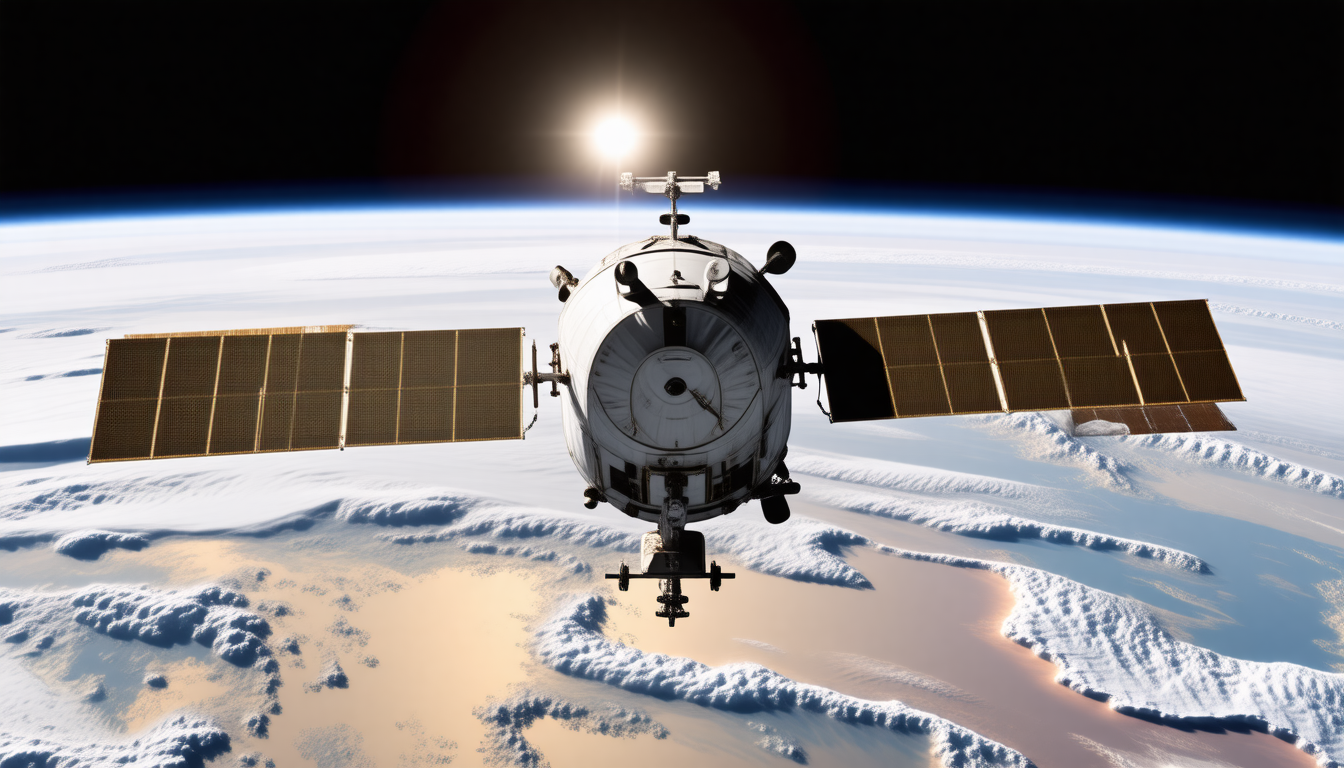Exploring Europa’s Secrets: The Quest for Life Beyond Earth

Mission Objectives and Significance
The Europa Clipper mission represents an extraordinary leap into the unknown as humanity’s curiosity drives it toward one of the most intriguing celestial bodies in our Solar System: Europa, a moon of Jupiter. Launched with the explicit purpose of probing beneath its icy surface, the mission aims to unravel the mysteries surrounding the possibility of an oceanic world teeming with conditions conducive to life. Scientists posit that beneath the thick crust of ice lies a vast, salty ocean, a dynamic environment that could harbor microbial life, perhaps similar to the earliest forms of life that appeared on Earth. The sheer scope of this mission extends our quest for extraterrestrial existence, transforming our understanding of life’s potential in the universe.
One of the primary objectives of Europa Clipper is to investigate the thickness and composition of Europa’s icy shell and to determine the existence of a subsurface ocean. Advanced remote sensing technologies will enable the mission to create detailed maps of the ice shell’s characteristics, identifying varying terrains and the geological processes that shaped them. By employing an array of scientific instruments, the mission seeks to confirm hypotheses about the moon’s hidden ocean and its chemical makeup, thus providing critical insights into its potential habitability.
Furthermore, Europa Clipper aims to explore the moon’s intriguing surface features, including its cryovolcanic activity, which suggests that there could be sunlight-driven phenomena influencing the ocean beneath. The presence of water vapor plumes observed by previous missions bolsters the case for active geological processes. Deciphering the nature of these plumes—whether they are sourced from the ocean or are merely surface phenomena—will provide vital clues about the moon’s geological activity and its capacity to support life.
The mission’s scientific ambitions extend to the pursuit of organic compounds that may be essential for life as we know it. Instruments designed to analyze surface materials will focus on detecting molecular signatures, such as the presence of amino acids or other complex organic molecules. These compounds serve as the building blocks of life, and their detection would profoundly impact our understanding of the evolution of life beyond Earth.
Moreover, the Europa Clipper mission embodies a collaborative effort between NASA and the scientific community, bringing together minds from diverse fields of study to tackle complex questions. This joint venture underscores the significance of international cooperation in advancing our exploration of space. The findings from Europa Clipper could drive further missions, possibly paving the way for future landers that could directly sample the ocean’s composition.
While the mission does explore the prospect of discovering life, it is grounded in scientific prudence. The search for extraterrestrial life remains a tantalizing pursuit, filled with uncertainties and complexities. Even if Europa Clipper detects signatures of biology—such as organic molecules or chemical processes that could support life—scientists will place these findings in context, rigorously evaluating the evidence. The mission is guided not only by a thirst for discovery but also by an ethical responsibility to understand the implications of our encounters with potential extraterrestrial life.
Ultimately, Europa Clipper stands at the frontier of human knowledge, ready to unveil the secrets of one of the most enigmatic objects in our celestial neighborhood. Its success could redefine our view of life’s potential in the universe, challenging notions that restrict life to warm, sunlit planets and expanding the horizons of our cosmic perspective. This mission symbolizes a chapter in the larger narrative of humanity’s quest to comprehend our place in the cosmos, where every discovery has the potential to reshape our understanding of life, existence, and the profound connections that bind us to the universe at large.

Technological Innovations of Europa Clipper
The Europa Clipper spacecraft emerges as an engineering marvel, reflecting the pinnacle of contemporary space exploration technology designed to withstand the extreme conditions of the Jovian environment. This mission not only aims to uncover the mysteries of Europa but is also an exhibition of cutting-edge innovations that can propel our understanding of the cosmos into the future.
At the heart of Europa Clipper’s design is its robust sun-synchronous orbit operation, which allows it to maximize the power harvested from the sun despite the great distance it travels to reach Jupiter. This spacecraft is equipped with expansive solar panels, each composed of five segments, stretching an impressive total of about 15 meters in length. These panels are tailored to capture as much sunlight as possible, vital for a mission stationed in a region where solar irradiance is a mere fraction—approximately one twenty-seventh—of what we experience on Earth. Generating about 700 watts of power, these solar panels stand as the largest ever designed for interplanetary spacecraft, exhibiting both ingenuity and necessity in adapting to environmental challenges.
Moreover, the structural integrity of Europa Clipper is fortified against the intense radiation that bathes Jupiter and its moons. Tucked within a protective aluminum and titanium shell, the sensitive electronics of the spacecraft are shielded from the ionizing radiation that could otherwise compromise scientific instruments and onboard systems. This radiation-hardened design is critical, considering that Europa’s outer layer is bombarded by charged particles from Jupiter’s magnetic field, making any sustained mission challenging and necessitating advanced engineering solutions.
In terms of exploration capabilities, Europa Clipper is outfitted with an impressive suite of nine scientific instruments, each purpose-built for specific functions that will collaboratively enhance our understanding of Europa’s environment. These instruments range from high-resolution cameras capable of detailed topographic mapping of the icy surface to spectrometers that will analyze the chemical composition of the moon’s surface and plumes of water vapor that may erupt from beneath the crust.
- High-Resolution Cameras: The advanced cameras will produce stereoscopic images, mapping nearly 90% of Europa’s surface at an astounding resolution that transcends previous missions. Such detailed imaging helps to reveal geological features and surface temperatures.
- Thermal Imager: Capable of detecting heat emanations, it aims to identify hot zones indicative of subsurface ocean currents or upwellings that could suggest more active geological processes.
- Mass Spectrometer: This apparatus will be instrumental in analyzing gases ejected by the anticipated water vapor plumes, seeking out clues about the moon’s potential habitability.
- Magnetometer: Designed to probe the magnetic field, this device will determine the salinity and depth of the underlying ocean while identifying the crystal structure of the icy shell above.
- Radar System: The ice-penetrating radar will enable scientists to visualize the internal structure of the ice shell, providing data on its thickness and identifying liquid water reservoirs beneath.
Additionally, these instruments employ multiple methods to gather data, ensuring that Europa Clipper can execute diverse scientific strategies during its planned 49 flybys. Each flyby presents a unique opportunity to collect data from slightly different environmental conditions, enriching the data set available to scientists back on Earth. The spacecraft’s ability to adjust its flight path through gravitational assists from Europa’s fellow Galilean moons further enhances its exploratory potential.
Another notable aspect of Europa Clipper is its innovative thermal management system, which balances the extremes of space temperature. The design not only protects its instruments from the cold of space but also prevents overheating during close flybys, where all systems operate at full capacity. This delicate balance is achieved using fluid circulation systems that redistribute heat effectively, ensuring operational integrity throughout the mission’s duration.
Through these technological advancements, Europa Clipper is set to redefine our methodologies for planetary exploration. It symbolizes a step forward in our capabilities, not merely in probing Europa but serving as a prototype for future missions targeting other celestial bodies with extreme conditions. As scientists gear up for the anticipated data that this mission will return, Europe Clipper embodies our age-old quest to explore the unknown, enhance our scientific understanding, and perhaps, identify signs of life beyond our terrestrial home.

Expected Discoveries and Implications for Extraterrestrial Life
The Europa Clipper mission, with its visionary agenda, stands as a beacon of hope in the search for extraterrestrial life. As researchers, engineers, and scientists prepare to explore the heart of this enigmatic moon, the implications of their findings could stretch far beyond the confines of our solar system. The prospect of discovering life in the frigid ocean beneath Europa’s thick ice shell tantalizes the imagination, and every scientific instrument aboard the Clipper is designed with this ultimate goal in mind.
At the crux of the mission’s research ambitions is the tantalizing possibility that Europa harbors microbial life within its vast subsurface ocean. This ocean, which many believe to be more voluminous than all of Earth’s oceans combined, is kept in a liquid state not just by the heat from the moon’s core, but also by the incessant tidal forces exerted by Jupiter. These forces cause constant stretching and flexing of Europa’s ice crust, generating heat via friction—a process reminiscent of how Earth’s tectonic activities can nurture life. If life exists in these saline waters, it may thrive in conditions vastly different from those on Earth, challenging our conceptions of life’s adaptability.
Central to effective exploration are the chemical analyses conducted by the Clipper’s onboard instruments. By investigating the composition of the moon’s icy mantle and any potential plumes of water vapor that erupt from beneath, scientists will seek to identify organic compounds—key components for life as we know it. The mass spectrometers and spectrometers aboard the spacecraft are particularly vital for this endeavor, as they will be capable of detecting complex molecules that could serve as the building blocks for life, including amino acids and other organic molecules.
In addition to the search for organic compounds, the mission’s objectives encompass the deeper geological processes that define Europa’s surface. As data flows back to Earth, scientists will scrutinize the geological structures revealed by advanced imaging systems. Analyzing these features not only aids in determining the history of this celestial body but also in understanding its current dynamics. Insights into the moon’s cryovolcanism—likely driven by subsurface oceanic movements—might reveal active processes that could harbor life, reopening the debate on whether such environments can sustain biological systems.
Furthermore, the mission’s emphasis on mapping the thickness and characteristics of Europa’s ice shell cannot be overstated. Understanding whether this ice layer acts as a barrier or a gateway to the ocean below will play an important role in determining the habitability of this icy world. Should the Clipper confirm that the ice shell is relatively thin in certain regions, it may pave the way for future missions designed to penetrate the surface and probe the ocean directly—missions that could bring us closer than ever to answering the question of whether we are alone in the universe.
Another profound aspect of the mission is its broader implications for astrobiology. If Europa Clipper does reveal compelling evidence of life or conditions pertinent to life, it would fundamentally alter our understanding of where life can thrive—not just within our solar system but potentially across the cosmos. The recognition that extraordinary biological processes can exist in extreme environments—even those starkly different from Earth—would expand the scope of astronomical exploration and deepen our quest to understand life’s resilience and diversity.
As the Europa Clipper sails toward Jupiter, its findings will not only contribute to our understanding of this remarkable moon but could also inspire future generations of scientists, astronauts, and engineers. The pursuit of knowledge, coupled with the inspirational possibility of extraterrestrial life, drives humanity to venture into the unexplored territories of our solar system. Each flyby of Europa represents a step deeper into the unknown, a scientific odyssey that could potentially redefine existence and our place within the universe.